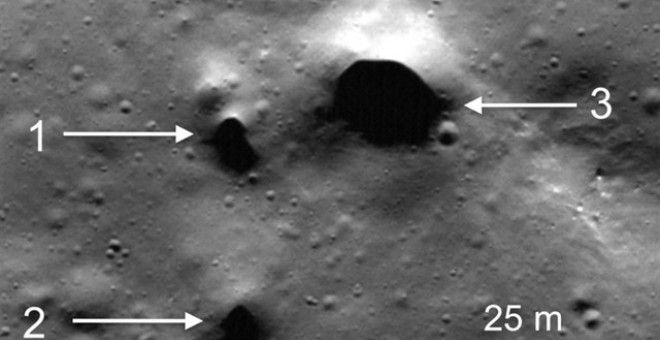NASA discovers a network of underground passages in the north pole of the Moon

Small wells in a large crater near the North Pole of the Moon can be entrances to an underground network of lava tubes, which can facilitate access to ice accumulated in the craters.
The wells have been identified by the SETI Institute and the Mars Institute through the analysis of image data from the Lunar Reconnaissance Orbiter (LRO, or NASA Lunar Reconnaissance Orbiter). If there is water ice present, these potential "skylights" could allow future explorers easier access to underground ice, and therefore water, than if they had to dig the "regolith" (surface debris) at the lunar poles.
The new wells were identified on the northeast floor of Philolaus Crater, a large impact crater 70 kilometers in diameter located at 72.1oN, 32.4oW, approximately 550 kilometers from the Moon's North Pole, on the near side of the moon. The wells appear as small depressions without borders, typically 15 to 30 meters, with completely shaded interiors.
The wells are located along sections of winding canals, known on the Moon as "sinuous grooves," which intersect in the soil of Philolaus Crater. In general, it is believed that the sinuous lunar stripes collapsed, or partially collapsed, these lava tubes, the underground tunnels that were once lava flows in motion.
"The higher resolution images available for Philolaus Crater do not allow wells to identify themselves as lava tube skylights with a 100% certainty, but we are looking for good candidates while considering their size, shape, lighting conditions and geological configuration" , said in a statement Pascal Lee, planetary scientist at the SETI Institute and the Mars Institute, who made the new finding at the NASA Ames Research Center in Silicon Valley.
Before this discovery, other researchers had found more than 200 wells on the moon, many of whom were identified as potential skylights leading to underground lava tubes associated with similar sinuous grooves. However, the new announcement represents the first published report of possible lava tube skylights in the polar regions of the Moon.
The new discovery opens up an exciting prospect: a potentially much easier access for removal of the lunar polar ice and its conversion into liquid water to supply permanent lunar colonies in the area.
Three factors might help: 1) skylights and lava tubes could provide more direct access to the lunar polar cold ground, alleviating the need to excavate large amounts of lunar regolith; 2) if there is ice inside the lava tubes, it could be in the form of massive ice formations, as is usually the case in cold lava tubes on Earth, instead of mixing within the lunar sand, and 3) the energy solar would be available nearby, just outside each skylight.

Up voted a ton of things, followed and liked a bunch of your stuff share the love.
Congratulations! This post has been upvoted from the communal account, @minnowsupport, by ronald93 from the Minnow Support Project. It's a witness project run by aggroed, ausbitbank, teamsteem, theprophet0, someguy123, neoxian, followbtcnews, and netuoso. The goal is to help Steemit grow by supporting Minnows. Please find us at the Peace, Abundance, and Liberty Network (PALnet) Discord Channel. It's a completely public and open space to all members of the Steemit community who voluntarily choose to be there.
If you would like to delegate to the Minnow Support Project you can do so by clicking on the following links: 50SP, 100SP, 250SP, 500SP, 1000SP, 5000SP.
Be sure to leave at least 50SP undelegated on your account.